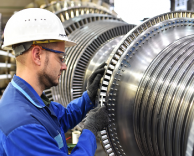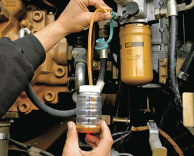Over greasing: The Silent Killer of Your Equipment and How to Avoid It
Introduction: The Overlooked Threat of Over greasing
In the world of industrial machinery, proper maintenance is key to ensuring the longevity and efficiency of
your equipment. However, one maintenance issue that often goes unnoticed and can cause significant harm is
over-greasing. Many companies focus on keeping machinery well-lubricated but fail to recognize that
excessive lubrication can lead to costly breakdowns, unplanned downtime, and even irreparable damage.
In this article, we will explore the dangers of over-greasing, why it occurs, and how you can avoid it to
ensure the optimal performance of your equipment.
What is Overgreasing?
Over-greasing occurs when excess grease is applied to a component, typically beyond the recommended amount. While it may seem like adding more lubrication would improve the performance of your equipment, too much grease can result in a range of problems that actually compromise machinery performance and cause long-term damage.
Common Causes of Overgreasing
Over-greasing often happens due to several reasons, including:
- Lack of Understanding: Operators may not be fully aware of the correct lubrication requirements for different components and may apply too much grease, thinking it will help.
- Improper Maintenance Schedules: Without regular checks and maintenance schedules, over-greasing can occur when equipment receives more grease than needed during routine servicing.
- Faulty Grease Guns: Malfunctioning grease guns or those with incorrect pressure settings can result in an excessive flow of grease, leading to over-greasing.
- Inaccurate Greasing Procedures: Sometimes, a failure to follow manufacturer-recommended lubrication procedures can result in the application of excessive grease.
The Dangers of Overgreasing
1. Increased Friction and Heat
Excess grease may not always be able to fully dissipate or circulate throughout the system, causing heat buildup within the bearings and seals. This can increase friction and reduce the effectiveness of the lubrication, potentially leading to the rapid deterioration of key components. This heat buildup is particularly problematic in high-speed, high-load applications where overheating can cause catastrophic damage.
2. Seal and Bearing Damage
The excess grease can place pressure on seals, causing them to deform or leak. When the seals fail, contaminants such as dirt, water, and dust can enter the system, leading to increased wear and tear on the bearings. This can result in premature bearing failure, which can be extremely costly to replace.
3. Blocked Lubrication Pathways
In some cases, too much grease can cause clogging within the lubrication system, preventing the grease from properly reaching the critical points of the equipment. This blockage can prevent the essential lubrication from flowing into the areas that need it most, causing damage to moving parts.
4. Increased Energy Consumption
Excess grease can create resistance in the system, forcing the machinery to work harder to move. This additional drag increases energy consumption, which leads to higher operational costs and reduced efficiency.
5. Environmental Impact
Over-greasing also has an environmental impact. Excess grease can escape into the environment through seals and vents, leading to contamination. This can cause harm to surrounding ecosystems and result in costly cleanup efforts.
Calculating the Correct Amount of Grease
The Grease Calculation Formula
To determine the right amount of grease for a bearing, you can use the following formula:
Amount of Grease (oz)=Bearing Diameter (in)×Width (in)×0.114
Example Calculation
For a bearing with an outside diameter of 3 inches and a width of 0.5 inches:
3×0.5=1.5 (Bearing Volume)
1.5×0.114=0.17 oz (or 4.8 grams)
Thus, 0.17 ounces or 4.8 grams of grease is required.
Solving Overgreasing Issues
Importance of Frequency Control
Once you know how much grease to apply, mastering the greasing frequency is essential. Reference industry charts and tables to schedule lubrication intervals.
Tools and Techniques to Avoid Over-greasing
- Calibrate Grease Guns: Ensure accurate grease volume per pump.
- Monitor Pressure: Stop greasing immediately if abnormal pressure is encountered.
- Choose the Right Tools: While manual grease guns are cost-effective and allow for equipment inspection, they can sometimes lead to over/under lubrication due to poor control.
How to Determine the Right Amount of Grease
Finding the correct balance between overgreasing and undergreasing requires careful consideration of several factors, including equipment type, operational conditions, and grease specifications.
1. Equipment Type and Load Conditions
Heavy-duty machines like crushers, mills, or turbines require more lubrication due to the higher load and more frequent operation. Lighter-duty equipment like fans or conveyors may require less. Understand the specific needs of your equipment to determine the correct lubrication levels.
2. Operating Environment
Machines operating in dusty or wet environments need more frequent lubrication to protect against contamination. Machines in controlled or clean environments might require less. Also, high temperatures may cause grease to thin out, requiring additional applications.
3. Grease Type and Consistency
The type of grease used significantly affects the amount required. Different greases have varying viscosities and resistance to temperature extremes. High-temperature grease or special-purpose greases might need to be applied more often than standard greases.
4. Grease Application Methods
The method used to apply grease plays a crucial role in determining the correct amount. Manual grease guns can be less precise than automatic systems, leading to either over or under-greasing. Implementing a centralized lubrication system can help maintain the right balance of grease throughout the entire operation.
Best Practices for Effective Greasing
To ensure your machinery is optimally lubricated, follow these best practices:
1. Stick to Manufacturer Recommendations
Always follow the lubrication guidelines provided by the manufacturer. These guidelines include the type of grease, the amount, and the recommended application intervals. They have been developed based on extensive testing to ensure the longevity and reliability of the equipment.
2. Regularly Monitor Grease Levels
Regular monitoring of grease levels can help detect issues like overgreasing or undergreasing before they lead to significant damage. Check grease reservoirs and apply fresh grease as needed. Using tools like grease meters and pressure gauges can help you achieve more accurate readings.
3. Invest in Automatic Lubrication Systems
Automatic lubrication systems can significantly improve grease application accuracy, ensuring that the right amount of grease is applied at the right intervals. These systems also reduce the risk of human error and improve overall maintenance efficiency.
4. Avoid Grease Contamination
Grease can easily become contaminated by dirt, moisture, and debris, making it less effective. Ensure that all grease pumps, reservoirs, and application points are clean and free from contaminants. If necessary, use filters to remove impurities from the grease before applying it to equipment.
5. Educate Your Team
Proper lubrication requires a skilled team. Train your maintenance staff on the importance of effective greasing, the risks associated with over and under-greasing, and how to apply the correct amount of grease. Regular training ensures that everyone involved in maintenance understands the impact of lubrication on equipment health.
Conclusion
Over-greasing and under-greasing are common challenges in machinery maintenance. By calculating the correct grease amount, controlling the frequency, and setting up a robust maintenance program, you can ensure the longevity of your equipment.
FAQs:
- Increased friction and heat, leading to rapid deterioration of components.
- Seal deformation or failure, allowing contaminants to enter the system.
- Blocked lubrication pathways, restricting grease from reaching critical points.
- Increased energy consumption, raising operational costs.
- Environmental contamination from grease leakage.
- Stick to manufacturer recommendations for grease type, amount, and intervals.
- Use calibrated grease guns to ensure accurate application.
- Monitor pressure while greasing and stop if resistance is felt.
- Implement automatic lubrication systems for precision.
- Heat buildup in the bearing.
- Excess grease leaking from seals or vents.
- Increased resistance in the machinery, leading to higher energy consumption.
- Disassemble the bearing if possible and clean it thoroughly.
- Wipe away the excess with a clean cloth.
- Reapply the correct amount of grease as per the manufacturer’s recommendation.
- Base Oil: Provides lubrication.
- Thickener: Maintains grease consistency.
- Additives: Enhance properties like anti-corrosion, anti-wear, and temperature resistance.




